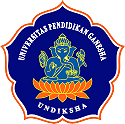Hubungan antara Regulasi Emosi dan Resiliensi pada Karyawan Selama Masa Pandemi Covid-19
DOI:
https://doi.org/10.23887/jurnal_bk.v7i1.1049Keywords:
regulasi emosi, resiliensi, covid-19Abstract
This study aims to determine the relationship between emotion regulation and resilience at PT. X employees at DKI Jakarta during the Covid-19 pandemic with 40 participants. Collecting data using the Emotion Regulation scale consisting of 17 items and the Resilience scale consisting of 52 items and both have met the requirements of good reliability. Data analysis used Pearson's product moment correlation technique. The results of this study indicate the correlation coefficient r2 = 0.893 with a significance value of 0.000 (p<0.05), meaning that there is a significant positive relationship between emotion regulation and resilience, namely the higher the emotional regulation, the higher the resilience. and conversely the lower the emotional regulation. the lower the resilience of employees of PT. X during the Covid-19 pandemic. The right emotional regulation can help individuals to always respond positively to any conditions or problems that will continue to occur during the COVID-19 pandemic.
Abstrak
Penelitian ini bertujuan untuk mengetahui hubungan antara regulasi emosi dengan resiliensi pada PT. X karyawan di DKI Jakarta selama masa pandemi Covid-19 dengan jumlah peserta 40 orang. Pengumpulan data menggunakan skala Regulasi Emosi yang terdiri dari 17 item dan skala Resiliensi yang terdiri dari 52 item dan keduanya telah memenuhi syarat reliabilitas yang baik. Analisis data menggunakan teknik korelasi product moment dari Pearson. Hasil penelitian ini menunjukkan koefisien korelasi r2 = 0,893 dengan nilai signifikansi 0,000 (p<0,05), artinya terdapat hubungan positif yang signifikan antara regulasi emosi dengan resiliensi, yaitu semakin tinggi regulasi emosi maka resiliensi semakin tinggi. dan sebaliknya semakin rendah regulasi emosinya. semakin rendah resiliensi karyawan PT. X selama pandemi Covid-19. Pengaturan emosi yang tepat dapat membantu individu untuk selalu merespon positif setiap kondisi atau masalah yang akan terus terjadi selama masa pandemi COVID-19.
References
Abidah, A., Hidaayatullaah, H. N., Simamora, R. M., Fehabutar, D., & Mutakinati, L. (2020). The impact of covid-19 to indonesian education and its relation to the philosophy of “merdeka belajar.” Studies in Philosophy of Science and Education, 1(1), 38–49.
Azwar, S. (2012). Penyusunan skala psikologi (edisi 2). Yogyakarta: Pustaka Pelajar. Badan Pusat Statistik. (2019). Diakses pada 2 Juni 2020, www.bps.go.id/dynamictable/2020/02/19/1774/tingkat-pengangguran-terbukatptmenurut-provinsi-1986---2019.html
Biggart, L., Ward, E., Cook, L., & Schofield, G. (2017). The team as a secure base: Promoting resilience and competence in child and family social work. Children & Youth Services Review, 83, 119-130.
Cole, P.M., Martin, S.E., & Dennis, T.A. (2004). Emotion regulation as a scientific construct methodological challenges and directions for child development research. Child development. March/April. 75 (2), 317-333.
Damon, W. (1998). Handbook of child psychology. Fifth edition volume four. New York: John Wiley & Sons. Inc.
Everall, R. D. (2006). Creating a future: A study of resilience in suicidal female adolescent. Journal of Counseling and Development, 84,461- 470.
Frijda, N. H. (1986). The emotions. London: Cambridge University Press.
Gross, J.J. (2007). Handbook of emotional regulation. New York : Guilford Press.
Gross, J.J., & John, O.P. (2003). Individual differences in two emotion regulation processes implications for affect, relationships and well-being. Journal of Personality and Social Psychology, 85(2), 348-362
Grotberg, E. (1998). I am, I have, I can: What families worldwide taught us about resilience. Reaching Today's Youth: The Community Circle of Caring Journal, 2(3), 36-39.
Gunarsa, S.D., & Gunarsa, Y. (1995). Psikologi praktis: Anak, remaja dan keluarga. Jakarta: BPK Gunung Mulia. Hartono, A., & Rahadi, D. R. (2021). Work from home terhadap kinerja karyawan pada masa pandemi covid 19. Jurnal Manajemen Bisnis, 18(1), 16-21.
Holaday, M., & McPherson, R. W. (1997). Resilience and severe burns. Journal of Counseling & Development, 75(5), 346-356.
Isaacson, B. (2002). Characteristics and enhancement of resilience in young people: a research paper. Diunduh dari the University of Winsconsin-Stout website: http://www.uwstout. ede/lib/thesis/2002/2002isaacsonb.pdf.
Kay, S. A. (2016). Emotion regulation and resilience: Overlooked connections. Industrial and Organizational Psychology, 9(2), 411-415.
LaFramboise, T. D. (2006). Family, community, and school influences on resilience among american indian adolescents in the upper midwest. Journal of Social Psychology, 34, 193-209.
Mulyani, S. 2011. Resiliensi daya pegas menghadapi trauma kehidupan. Medan: USU Press.
Pahlevi, G.R., & Salve, H. R. (2019). Regulasi emosi dan resiliensi pada mahasiswa merantau yang tinggal di tempat kos. Jurnal Psikologi, 11(2), 180-189.
Papalia, D. E., (2001). Human development eight edition. New York: McGraw Hil Republika.co.id (2020). Covid-19 terus meningkat, KAI batalkan 28 KA Jarak Jauh. Diakses pada 20 September 2021, https://republika.co.id/berita/ekonomi/korporasi/q7xlu9384/covid19-terus-meningkat-kai-batalkan-28-ka-jarak-jauh.
Rizki, B. M. (2010). Hubungan antara strategi regulasi emosi dan faktor demografi dengan resiliensi pada perempuan narapidana. Yogyakarta: Universitas Gadjah Mada.
Sugiyono. 2009. Metode Penelitian Kuantitatif, Kualitatif dan R&D. Bandung: Alfabeta Sukmaningpraja, A., & Santhoso, F. H. (2016). Peran regulasi emosi terhadap resiliensi pada siswa sekolah berasrama berbasis semi militer. Gadjah Mada Journal of Psychology (GamaJoP), 2(3), 184-191.
Troy, A.S., & Mauss, I. B. (2011). Resilience in the face of stress: Emotion regulation as a protective factor. Resilience and mental health: Challenges across the lifespan, 1(2), 30-44.
William, D., & Nancy, E. (2006). Handbook of child psychology. Vol. 3, PP. 648-718. Social, emotional, and personality development. New York: Wiley.
Putri, S. A. W., & Handayani, A. (2020). Hubungan antara kepercayaan diri dan regulasi emosi terhadap kecemasan menghadapi pertandingan pada atlet karate di kota demak. Proyeksi: Jurnal Psikologi, 15(1), 201–210





